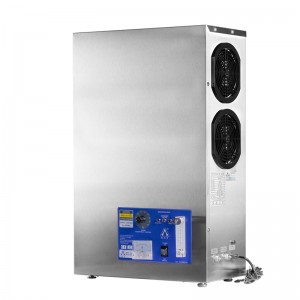Salts of Hbromate 3. Alkali bromate salts such as sodium bromate and potassium bromate dissolve in water. Bromate salts of alkaline earth metals, such as barium bromate Ba (BrO3) 2, are insoluble in water. They decompose easily when exposed to heat. There is oxidation. It is prepared by passing bromine vapor into the carbonate or hydroxide solution of the metal, and then separating the resulting bromide and bromate by crystallization.
Bromate is a toxic byproduct that is inevitably produced in the process of using ozone in various drinking water industry manufacturers for sterilization. Because the national drinking water standards are very strict on the total number of colonies, the inorganic disinfection byproduct bromate produced by using ozone to sterilize public drinking water is a potential carcinogen of class 2b by the International Agency for Research on Cancer.

What is bromate
Salts of Hbromate 3. Alkali bromate salts such as sodium bromate and potassium bromate dissolve in water. Bromate salts of alkaline earth metals, such as barium bromate Ba (BrO3) 2, are insoluble in water. They decompose easily when exposed to heat. There is oxidation. It is prepared by passing bromine vapor into the carbonate or hydroxide solution of the metal, and then separating the resulting bromide and bromate by crystallization.
Bromate is a toxic byproduct that is inevitably produced in the process of using ozone in various drinking water industry manufacturers for sterilization. Because the national drinking water standards are very strict on the total number of colonies, the inorganic disinfection byproduct bromate produced by using ozone to sterilize public drinking water is a potential carcinogen of class 2b by the International Agency for Research on Cancer.
New bromate standard
The relevant person in charge of the State Administration of Quality Supervision, Inspection and Quarantine revealed on July 4 that the revised draft of the national standard for drinking natural mineral water has been consulted online, and the bromate limit value in the new standard is initially set at 0.01mg/L.
According to relevant experts, under normal circumstances, the water does not contain bromate, but generally contains bromide. When ozone is used to disinfect water, the bromide reacts with the ozone and oxidizes to form bromate. The International Center for Research on Cancer (IARC) believes that potassium bromate has a carcinogenic effect on laboratory animals, but the carcinogenic effect of bromate on humans is not certain, so bromate is listed as a possible carcinogenic substance to humans.
In 1993, the World Health Organization set the limit value of bromate in water as 0.025mg/L in the “Drinking water quality Guidelines”, which was revised to 0.01mg/L in 2004. China’s current “sanitary standard for drinking water” also stipulates that the bromate limit is 0.01mg/L, which is consistent with the World Health Organization standard.
For bromate limits in mineral water, the International Codex Alimentarius Commission (CAC) has not made provisions, some other countries have provisions, some do not have provisions, there are provisions are not consistent, such as the European Union provisions for 0.003 mg/L, the United States provisions for 0.01mg/L. Since ozone was rarely used to disinfect water in early China, the national standard for Drinking Natural mineral Water did not set bromate limit requirements. However, in recent years, mineral water enterprises generally use ozone sterilization process, resulting in bromate phenomenon highlighted. In 2006, the National Standards Committee issued a revised plan for the “Drinking Natural Mineral Water” national standard, and conducted several studies on the bromate problem in mineral water, referring to the relevant international organizations and countries on bromate limits, the bromate limit in the national standard was initially set at 0.01mg/L.
Recently, the General Administration of Quality Supervision of the State of bottled water bromate special inspection work. Of the 104 kinds of bottled water that have been tested, 13 products have bromate content that exceeds the limit requirements of the “Sanitary Standard for Drinking Water”. Local quality inspection departments have informed the manufacturers of these products to immediately rectify. At present, the State Administration of Quality Supervision, Inspection and Quarantine is organizing special inspections, requiring all production enterprises to strengthen process control to ensure that the bromate content of mineral water meets drinking water standards.
Post time: Nov-11-2024


